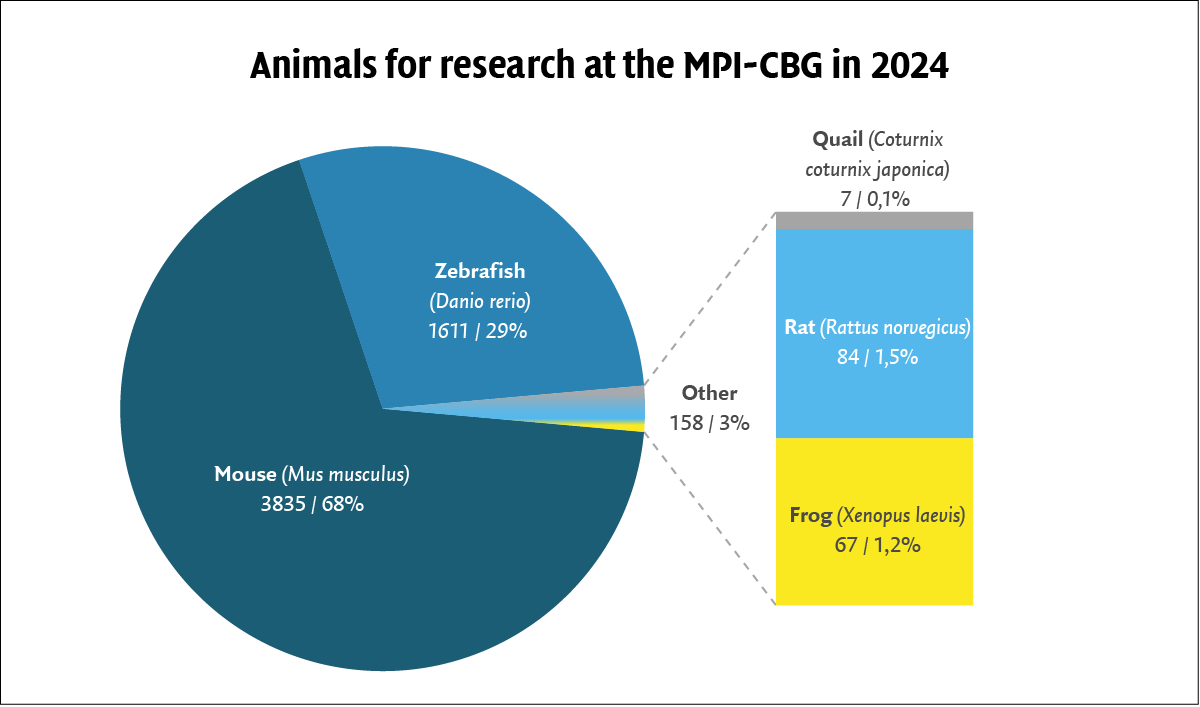
The experimental animals used by MPI-CBG researchers in 2024 are represented in the pie chart. The most frequently used experimental model in 2023 was the mouse (68%), followed by zebrafish (29%). The vast majority of animals were unharmed or experienced only mild stress or pain (94%). No procedures classified as severe were performed. The proportion of 'non-survival' procedures carried out under general anesthesia, as well as the proportion of animals used for organ and tissue removal (for further cell culture or organoid work, or for further analysis, e.g microscopy) following humane and painless euthanasia, was 5%. Experimental animals that were painlessly euthanized for the removal of biological material (e.g., cells, tissues, and organs) were not subjected to any other form of stress or procedure. Although most of our experiments cause little to no pain, we strive to minimize any distress by monitoring animal well-being daily (or continuously, if necessary). We follow predefined protocols to assess animal health and humane endpoints, and we use analgesics and other measures—such as providing an stress-free environment and gentle handling—to alleviate distress.
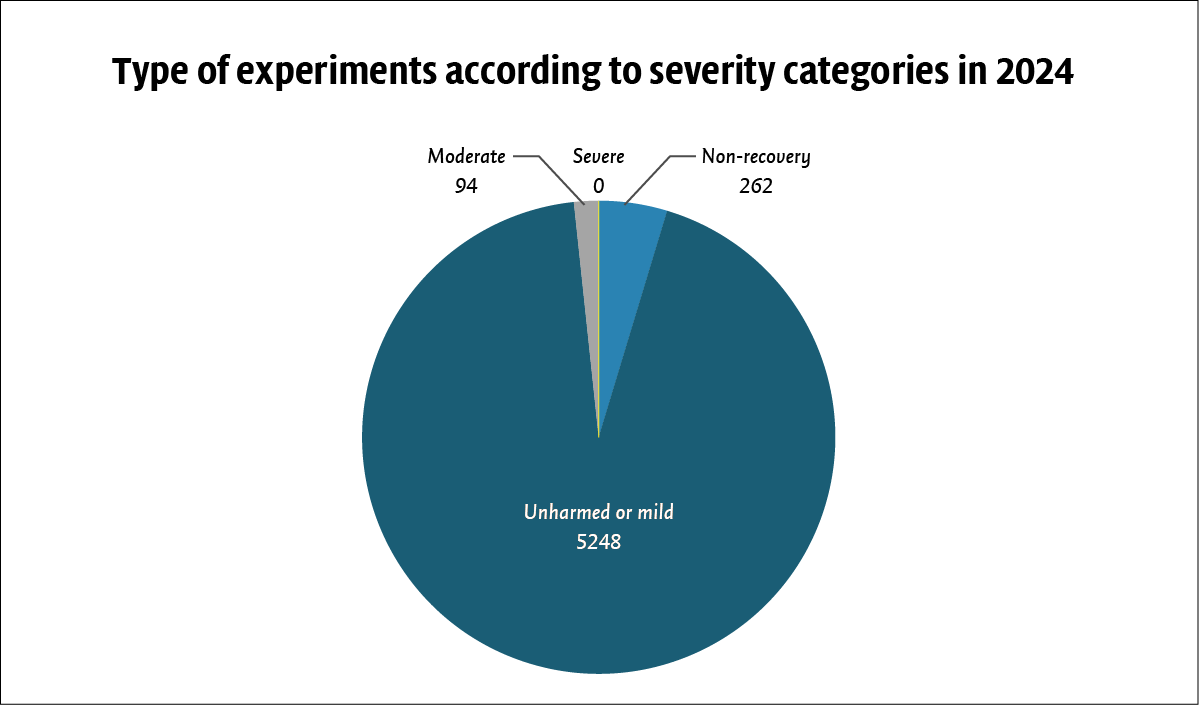
The types of experiments according to severity categories are defined by EU Directive 2010/63/EU (http://www.eara.eu/assessing-the-severity-of-animal-procedures). Definitions are shortly summarized below:
Non-recovery:
Procedures which are performed entirely under general anesthesia from which the animal shall not recover consciousness. Includes animals euthanized painlessly to obtain cells or tissues for cell culture (no experiments performed).
Unharmed or Mild:
Procedures on animals as a result of which the animals are likely to experience short-term mild pain, suffering or distress, as well as procedures with no significant impairment of the well-being or general condition of the animals. Typical examples may be a single injection or removal of a small tissue sample for genotyping purposes.
Moderate:
Procedures on animals as a result of which the animals are likely to experience short-term moderate pain, suffering or distress, or long-lasting mild pain, suffering or distress as well as procedures that are likely to cause moderate impairment of the well-being or general condition of the animals. Typical examples are simple survival surgeries such as introducing an imaging window for microscopy.
Severe:
Procedures on animals as a result of which the animals are likely to experience severe pain, suffering or distress, or long-lasting moderate pain, suffering or distress as well as procedures, that are likely to cause severe impairment of the well-being or general condition of the animals. We have never performed a procedure within this category.
2023
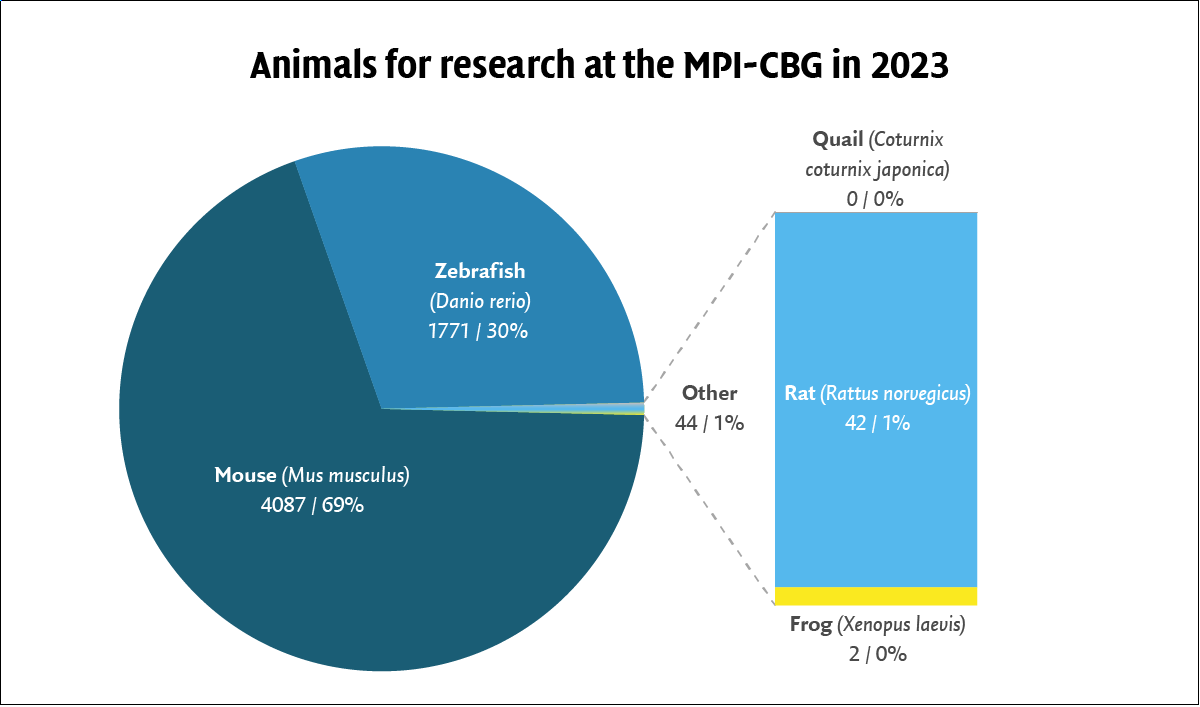
The experimental animals used by MPI-CBG researchers in 2023 are represented in the pie chart. The most frequently used experimental model in 2023 was the mouse (69%), followed by zebrafish (30%). The vast majority of animals were unharmed or experienced only mild stress or pain (91%). No procedures classified as severe were performed. The proportion of 'non-survival' procedures carried out under general anesthesia, as well as the proportion of animals used for organ and tissue removal (for further cell culture or organoid work, or for further analysis, e.g microscopy) following humane and painless euthanasia, was 8%. Experimental animals that were painlessly euthanized for the removal of biological material (e.g., cells, tissues, and organs) were not subjected to any other form of stress or procedure. Although most of our experiments cause little to no pain, we strive to minimize any distress by monitoring animal well-being daily (or continuously, if necessary). We follow predefined protocols to assess animal health and humane endpoints, and we use analgesics and other measures—such as providing an stress-free environment and gentle handling—to alleviate distress.
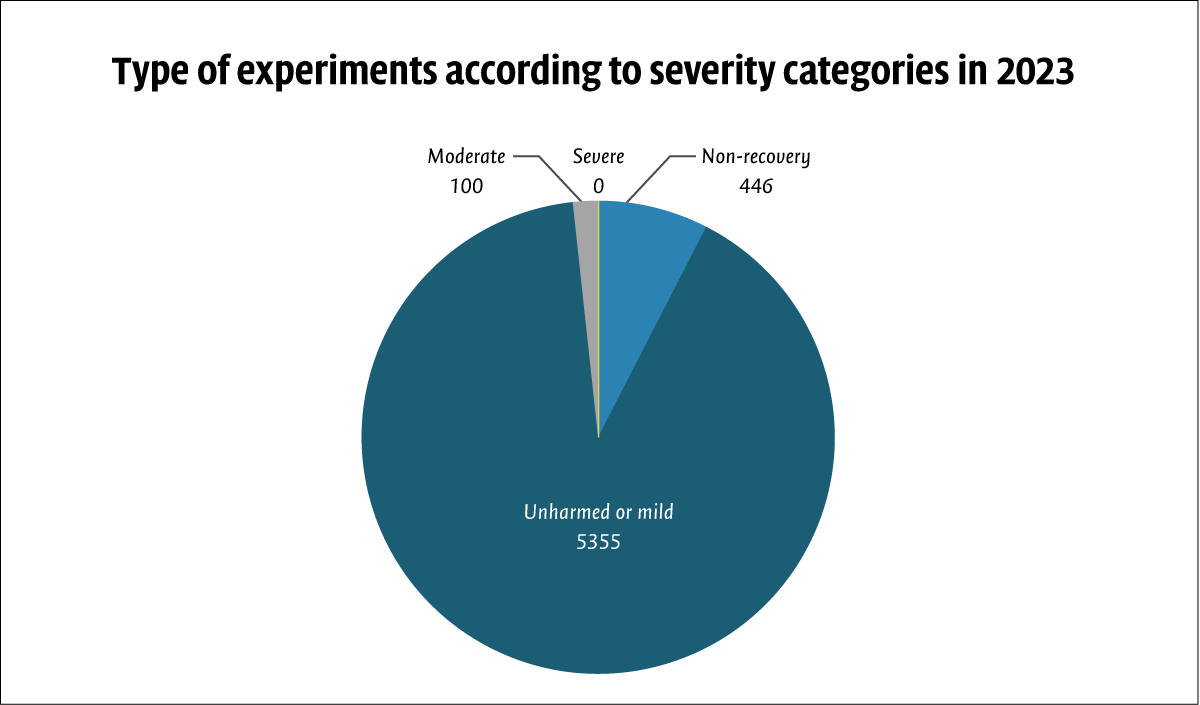
2022
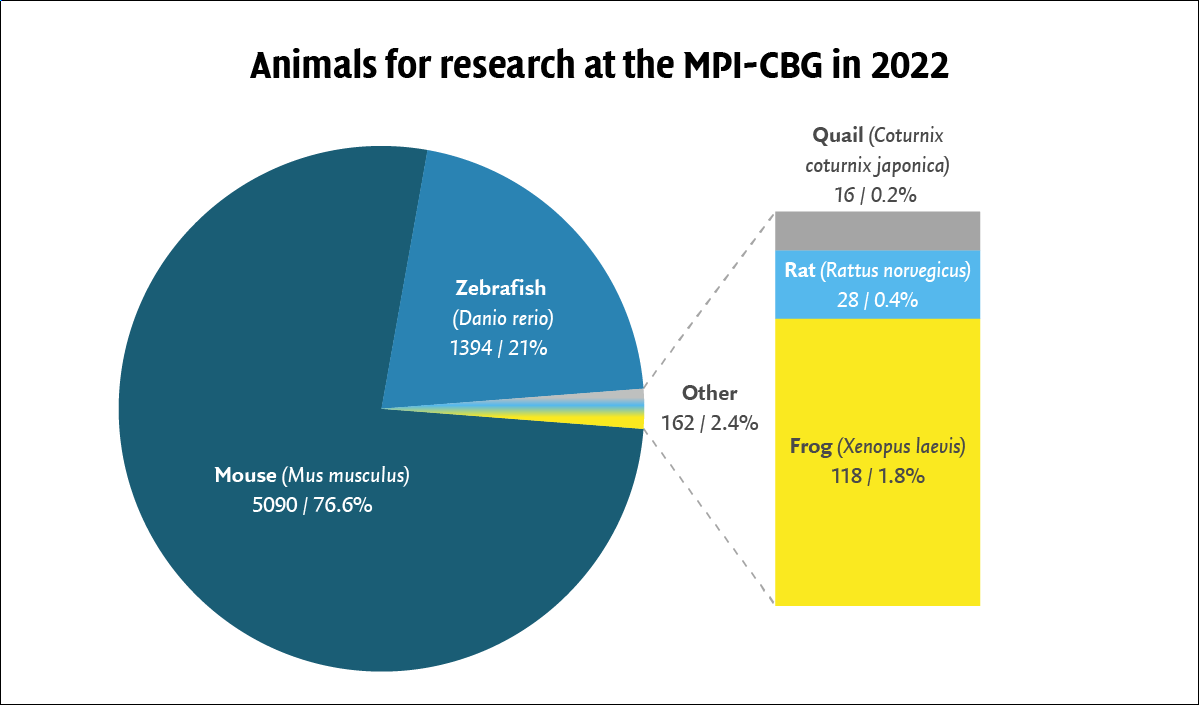
The experimental animals used by MPI-CBG researchers in 2022 are represented in the pie chart. The most frequently used experimental model in 2022 was the mouse (76,6%), followed by zebrafish (21%). The vast majority of animals were unharmed or experienced only mild stress or pain (94%). No procedures classified as severe were performed. The proportion of 'non-survival' procedures carried out under general anesthesia, as well as the proportion of animals used for organ and tissue removal (for further cell culture or organoid work, or for further analysis, e.g microscopy) following humane and painless euthanasia, was 4%. Experimental animals that were painlessly euthanized for the removal of biological material (e.g., cells, tissues, and organs) were not subjected to any other form of stress or procedure. Although most of our experiments cause little to no pain, we strive to minimize any distress by monitoring animal well-being daily (or continuously, if necessary). We follow predefined protocols to assess animal health and humane endpoints, and we use analgesics and other measures—such as providing an stress-free environment and gentle handling—to alleviate distress.
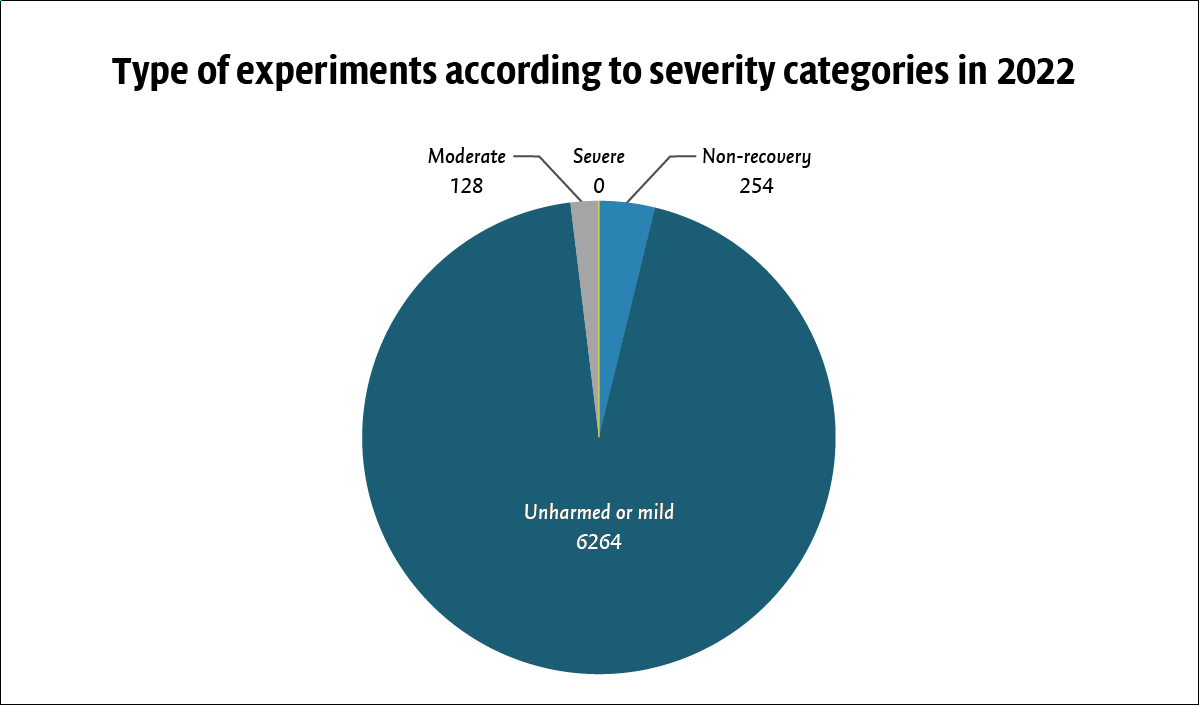
2021
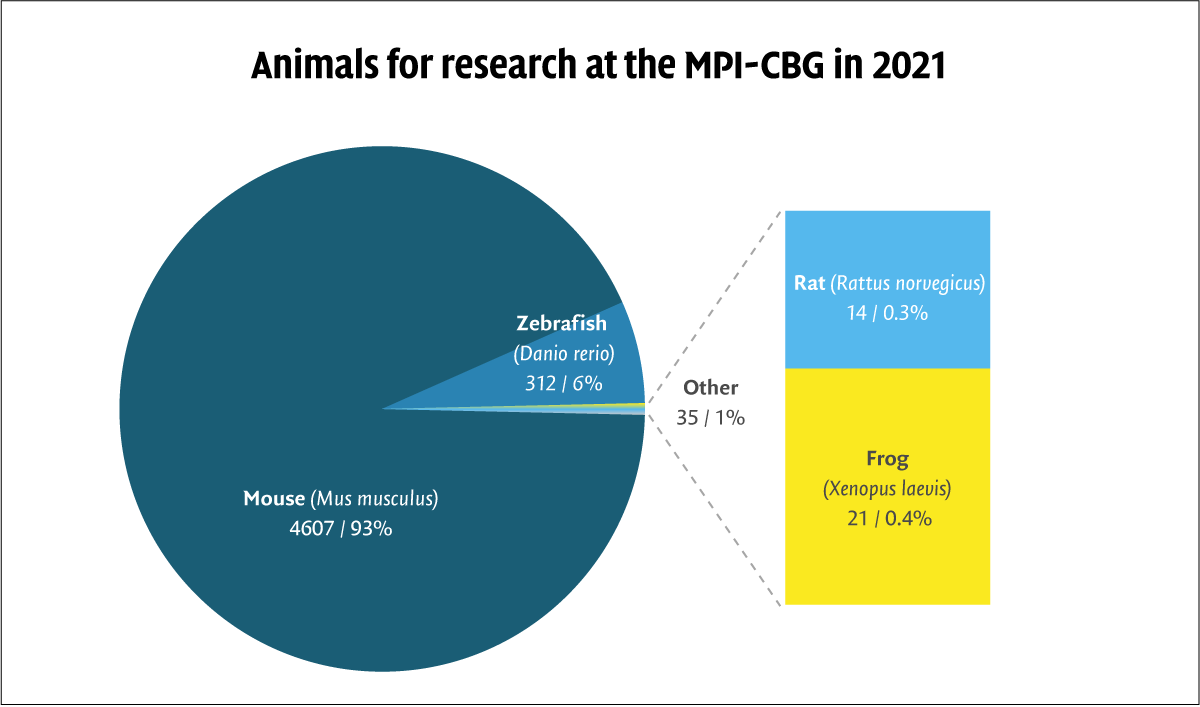
The experimental animals used by the MPI-CBG researchers in 2021 and registered with the authorities are shown in the pie chart. The most frequently used experimental model in 2021 was the mouse (93 %), followed by zebrafish (6 %). The majority of procedures carried out in 2021 were classified as mild (85%), and the proportion of moderate procedures was only 4%. We do not perform any procedures that are classified as severe. The proportion of 'non-survival' procedures carried out under general anaesthesia and the proportion of animals used for organ and tissue removal after humane and painless euthanasia, was 11%. Experimental animals that were painlessly euthanised for the removal of biological material (e.g. cells, tissues and organs) were not subjected to any other form of stress or procedure. Although most of our experiments cause little or no pain, we strive to minimise any distress by monitoring animal well-being daily (or continuously if needed), using predefined protocols to assess animal health and humane endpoints, and using analgesics and other measures (e.g. stress-free environment, gentle handling) to alleviate distress.
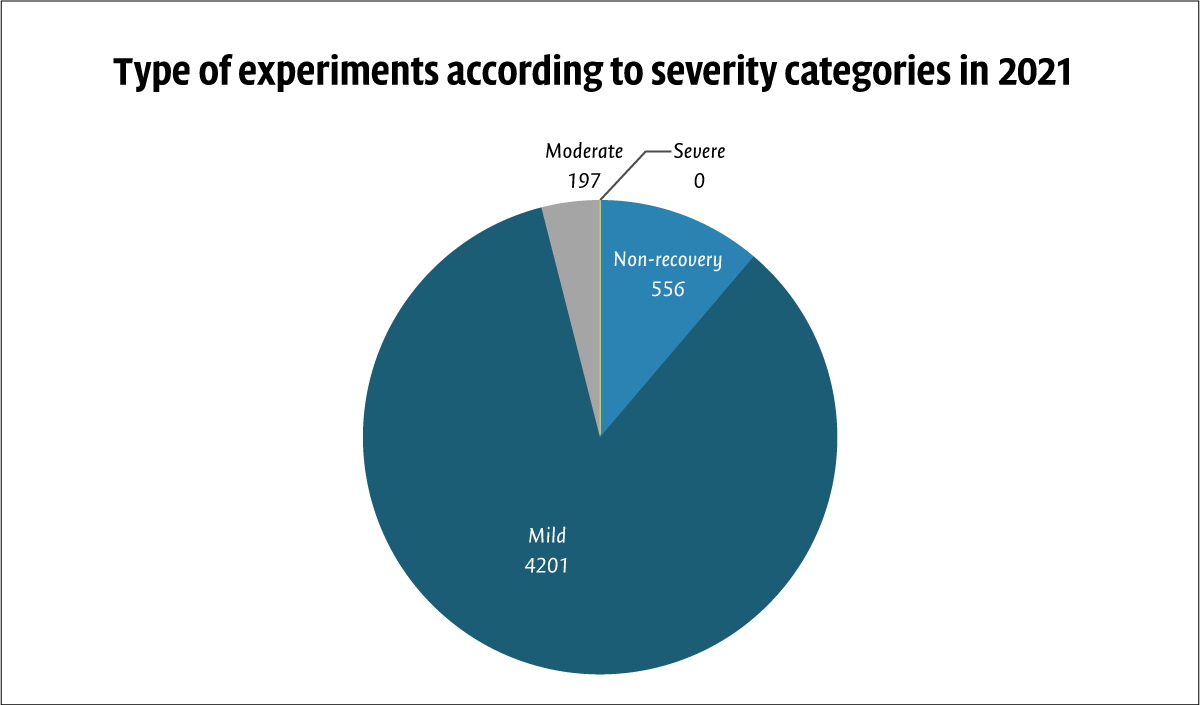
2020
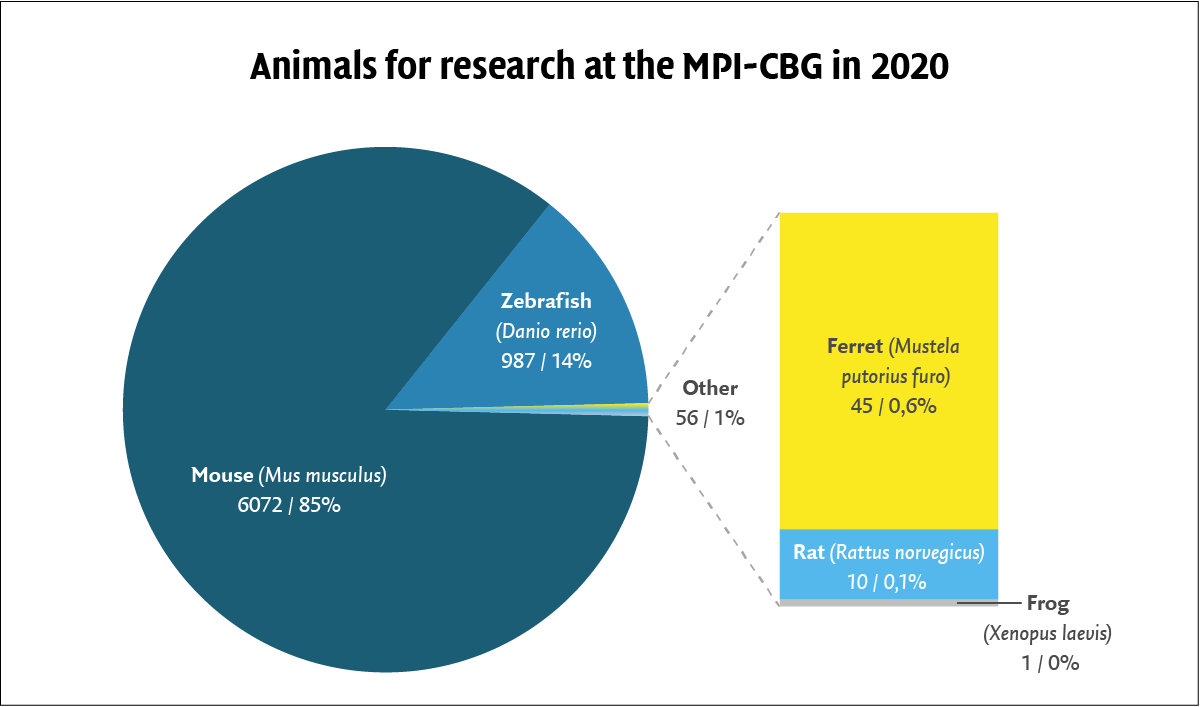
The experimental animals used by the MPI-CBG in 2020 and registered with the authorities are shown in the pie chart. The most frequently used experimental model in 2020 was the mouse (85 %), followed by zebrafish (14 %). The majority of procedures carried out in 2020 were classified as mild (86%), and the proportion of moderate procedures was only 1%. We do not perform any procedures that are classified as severe. The proportion of 'non-survival' procedures carried out under general anesthesia and the proportion of animals used for organ and tissue removal after humane and painless euthanasia, was 12%. Experimental animals that were painlessly euthanized for the removal of biological material (e.g. cells, tissues and organs) were not subjected to any other form of stress or procedure. Although the majority of our experiments cause little or no pain, we strive to minimize any distress by monitoring the animals' well-being daily (or continuously if needed), using predefined protocols to assess animal health and humane endpoints, and using analgesics and other measures (e.g. stress-free environment, gentle handling) to ease distress.
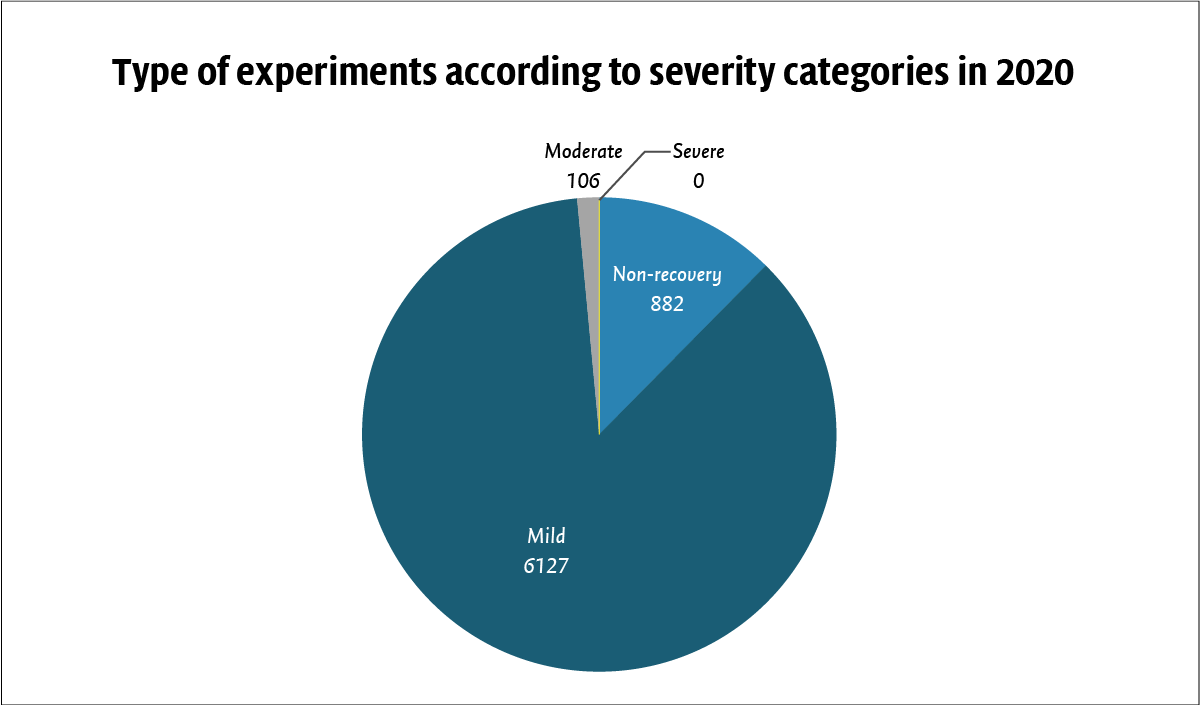
2019
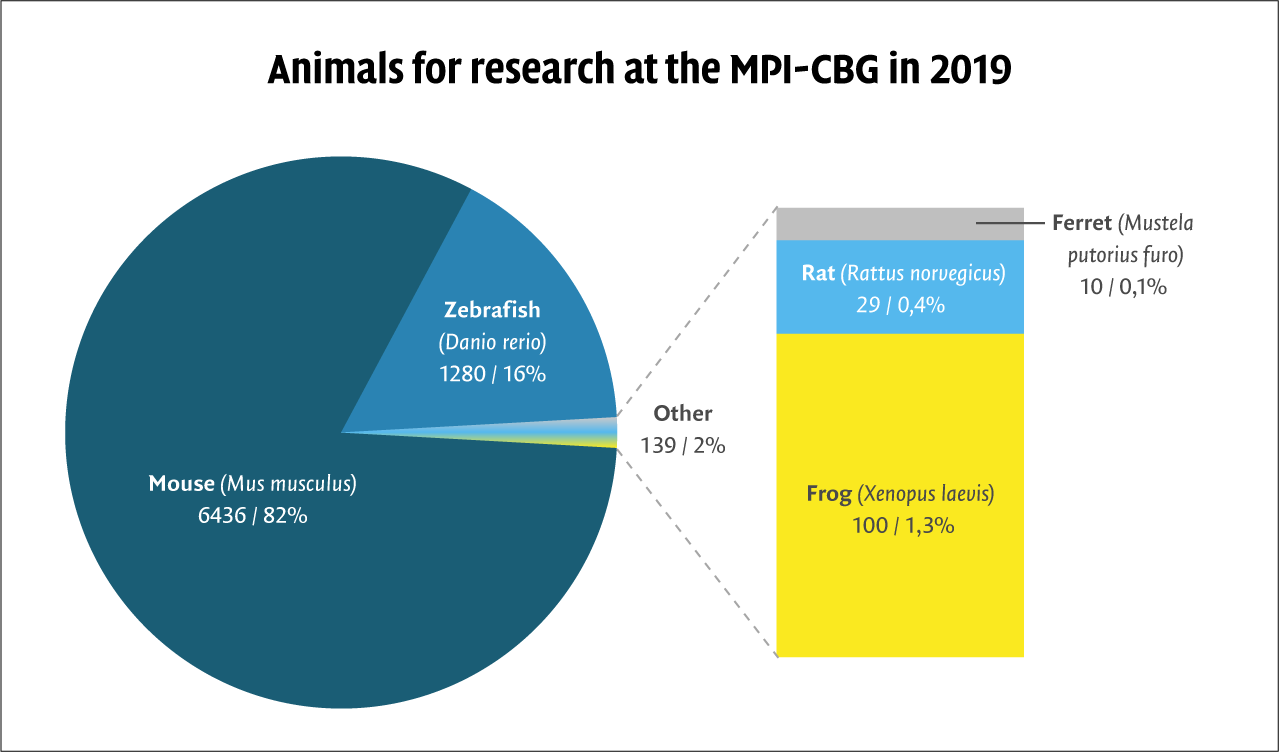
Experimental animals used by the MPI-CBG and registered with the authorities in 2019 can be seen in the pie chart. The most frequently used experimental model in 2019 was mouse (82%) followed by zebrafish (16%). In 2019, the majority of procedures carried out were categorized as being mild (78%); the proportion of moderate procedures was 3%. We do not carry out any procedures categorized as severe. The proportion of ‘non-survival’ procedures carried out under general anesthesia and the proportion of animals used for organ and tissue collection after humane and painless euthanasia, was 18%. Experimental animals which have been painlessly euthanized for the collection of biological materials (e.g. cells, tissues and organs) have not been subjected to any other form of stress or procedure. Although the majority of our experiments cause either no pain or only mild pain, if a procedure has the potential to cause suffering and/or pain, we are committed to keep this as low as possible by monitoring their well-being daily (or constantly if needed), using pre-defined scoresheets to evaluate humane endpoints, as well as applying analgesics and other measures (e.g. stress-free environment, gentle handling) to ease distress.
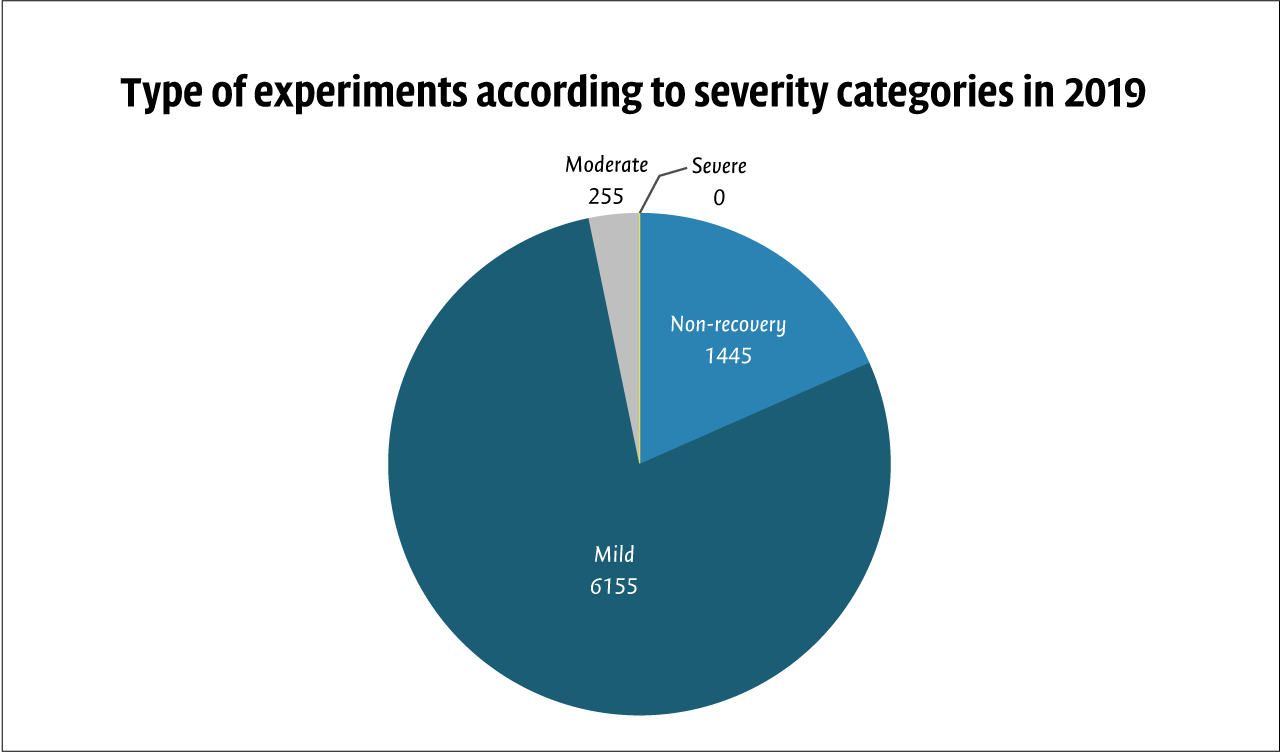
2018

Experimental animals used by MPI-CBG and registered with the authority in 2018 can be seen in the chart. Most common experimental model in 2018 was mouse (64%) followed by zebrafish (35%). In 2018, the majority of procedures carried out were categorized as being mild (67%); the proportion of moderate procedures was only 4%. We do not carry out procedures categorized as severe at all. The proportion of procedures carried out under general anesthesia, from which the animals did not recover, and from animals used for organ and tissue removal after killing was 28% in total (non-recovery). Experimental animals which have been killed painlessly in research only for the collection of biological samples (e.g. from cells, tissues and organs) have not been used in animal experiments or other studies. Although a vast majority of our experiments cause either no pain or only mild pain, some animals can experience moderate suffering – we are committed to keep the suffering as low as possible by applying analgesics and other measures (e.g. stress-free environment, gentle handling) to ease their distress.
